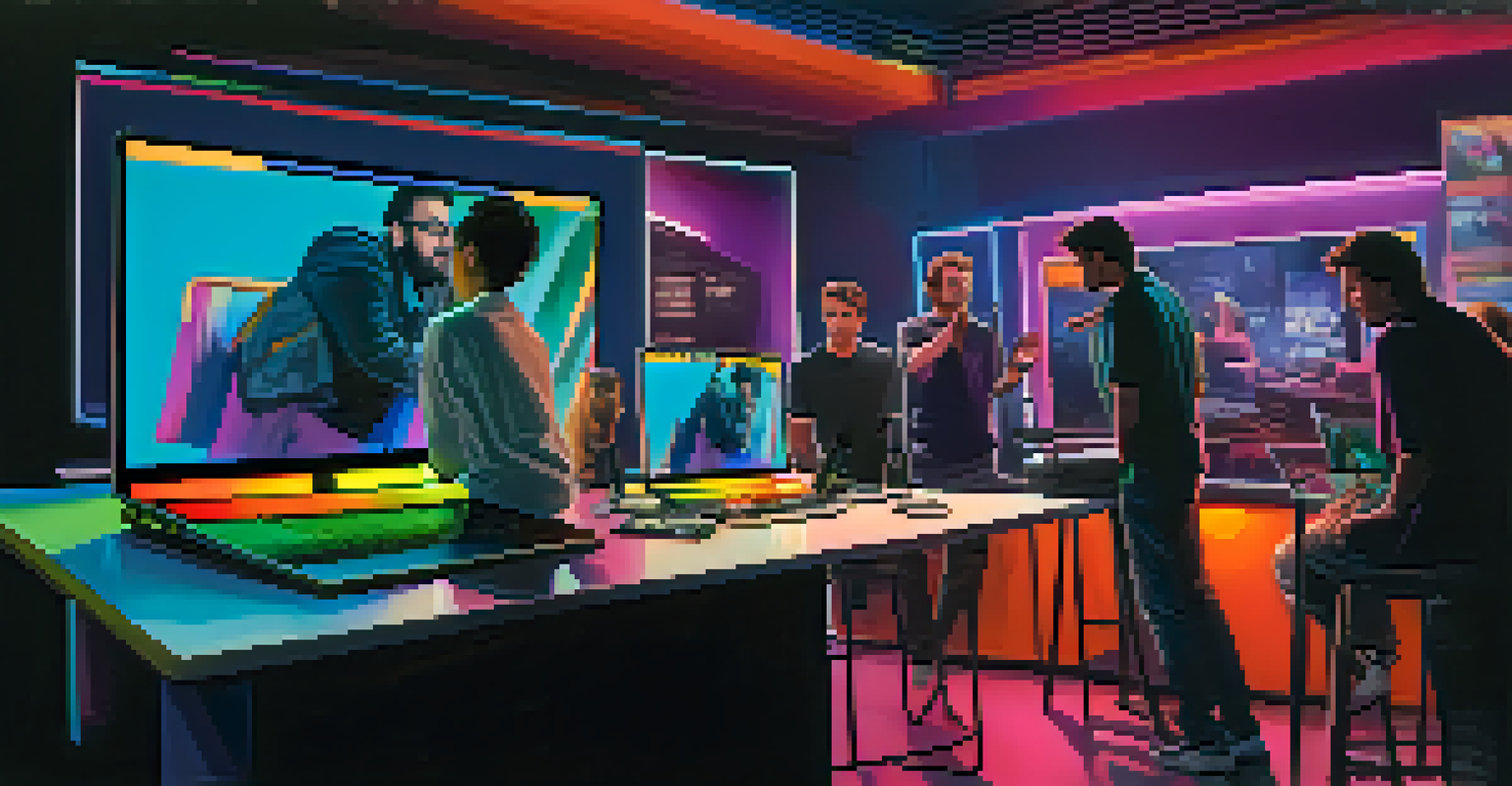The Impact of Social Media on Hollywood Storytelling Trends

The Rise of Social Media in Hollywood Narratives
Social media has become a powerful tool in the realm of storytelling, significantly influencing how narratives are crafted in Hollywood. Platforms like Instagram, Twitter, and TikTok allow creators to engage with audiences in real-time, giving rise to fresh and dynamic storytelling methods. This new approach often incorporates audience feedback, making the narrative more interactive and relatable.
Social media has transformed the way stories are told, making the audience an integral part of the narrative process.
For instance, many filmmakers now use social media to gauge audience reactions during production stages, allowing them to adjust storylines based on real-time feedback. This has led to a more collaborative approach to storytelling, where fans feel invested in the narrative journey. Consequently, stories are evolving into multi-platform experiences that span various media formats.
Moreover, social media provides a space for diverse voices and perspectives, enabling filmmakers to explore themes that resonate with a broader audience. As a result, Hollywood is embracing narratives that reflect current social issues, making storytelling not just a form of entertainment but also a catalyst for change.
Audience Engagement and the Role of Influencers
Audience engagement has taken on a new meaning in the age of social media, where influencers play a crucial role in shaping narratives. These digital personalities can sway public opinion and create buzz around a film or series, often before it even hits the screens. Their ability to connect with followers makes them invaluable partners for studios looking to promote their projects.

For example, movies are often marketed through influencer collaborations, where they share behind-the-scenes content or exclusive previews. This strategy not only builds anticipation but also creates a community of fans who feel personally connected to the project. Influencers can also help diversify storytelling by sharing their unique experiences, leading to more authentic representations on screen.
Social Media Transforms Storytelling
Platforms like Instagram and TikTok enable real-time audience feedback, leading to more interactive and collaborative narratives in Hollywood.
As a result, the partnership between filmmakers and influencers is transforming how stories are told and shared, making the audience an integral part of the narrative process. This shift encourages studios to consider viewer preferences and cultural conversations, ultimately enriching the storytelling landscape.
The Emergence of Serialized Storytelling
Serialized storytelling has gained traction in Hollywood, largely fueled by the binge-watching culture promoted by streaming platforms. Social media amplifies this trend, as viewers often discuss episodes in real-time, creating a communal viewing experience. This conversation allows for deeper engagement with the plot and characters, encouraging fans to invest time in the series.
The pressure to cater to audience demands can lead to a compromise in creative integrity.
Many shows now release episodes weekly instead of all at once, allowing for sustained conversations and theories among fans. This pacing not only keeps audiences engaged but also builds anticipation for each new episode. Social media platforms are often the breeding ground for fan theories and discussions, which can influence how stories unfold.
In essence, serialized storytelling benefits from social media by fostering a sense of community among viewers. This interconnectedness encourages studios to craft intricate plots that invite speculation, making the viewing experience more interactive and enjoyable.
Diversity and Representation in Storytelling
Social media has emerged as a powerful advocate for diversity and representation in Hollywood storytelling. Audiences are increasingly vocal about their desire for authentic portrayals of underrepresented groups, leading to a demand for more inclusive narratives. This shift has prompted filmmakers to rethink their approaches and embrace stories that reflect a variety of experiences.
For instance, campaigns on platforms like Twitter and Instagram have highlighted the importance of representation in film and television. Movements such as #RepresentationMatters have gained momentum, pushing studios to cast a wider net in terms of talent and storytelling. This not only enriches the narrative but also resonates with audiences who seek validation in their stories.
Influencers Shape Film Narratives
Influencers create buzz and engage audiences, allowing studios to build anticipation and diversify storytelling through authentic representations.
Consequently, Hollywood is gradually shifting towards narratives that prioritize diversity, allowing for a richer tapestry of human experiences. This evolution demonstrates how social media can serve as a catalyst for change, encouraging the industry to embrace stories that reflect the world we live in.
Real-Time Feedback and Story Adaptation
One of the most significant impacts of social media on Hollywood is the ability to receive real-time feedback from viewers. Filmmakers and showrunners can monitor audience reactions through comments, shares, and likes, allowing them to adapt narratives on the fly. This immediate connection can influence everything from character development to plot twists.
For example, a show may introduce a character that resonates well with viewers, leading writers to expand their role in subsequent episodes. Conversely, if a storyline doesn't land well, creators can pivot quickly to address audience concerns. This agility in storytelling fosters a sense of responsiveness that was previously absent in traditional media.
Thus, social media empowers creators to make informed decisions based on audience preferences, enhancing the overall viewing experience. This dynamic interaction between creators and fans creates a more engaging and personalized narrative journey.
The Role of User-Generated Content
User-generated content (UGC) is another fascinating aspect of how social media is impacting Hollywood storytelling. Fans are not just passive consumers; they are active participants in the storytelling process. This engagement can take many forms, from fan art and videos to elaborate theories that reimagine existing narratives.
Many studios have embraced UGC as a marketing strategy, encouraging fans to create content related to their favorite shows or films. This not only boosts engagement but also fosters a sense of community among fans. For instance, fan-created memes or videos can go viral, generating buzz and drawing new audiences to the original content.
Diversity Drives Modern Narratives
Social media advocates for inclusive storytelling, prompting filmmakers to reflect a wider range of experiences and perspectives in their work.
Ultimately, UGC allows for a richer narrative experience, as fans contribute their perspectives and creativity to the story. This collaborative environment enhances the bond between creators and audiences, making storytelling a shared journey.
Challenges and Criticisms of Social Media Influence
While social media has revolutionized storytelling in Hollywood, it also presents unique challenges and criticisms. The pressure to cater to audience demands can lead to a compromise in creative integrity. Some creators may feel compelled to chase trends rather than stay true to their artistic vision, resulting in formulaic storytelling.
Additionally, the rapid pace of social media can create a culture of instant gratification, where audiences expect immediate results and responses. This can hinder the development of nuanced and complex narratives, as creators may prioritize quick, engaging content over more thoughtful storytelling. The emphasis on virality can overshadow the importance of depth and quality.

Moreover, the potential for negative feedback can discourage creators from taking risks, leading to a less diverse range of stories. Balancing audience engagement with creative authenticity remains a challenging yet crucial aspect of modern Hollywood storytelling.